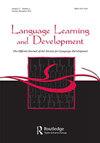A Collective-Distributive Pragmatic Scale and the Developing Lexicon
IF 1.4
2区 文学
0 LANGUAGE & LINGUISTICS
引用次数: 4
Abstract
ABSTRACT A locus of the difference in meaning between distributive and collective sentences can be the quantifiers that modify their subjects. A current theoretical account of distributive and collective sentences claims that sentences with quantifiers such as the in English, or los in Spanish, in subject position and an indefinite direct object, modified by a in English, or una in Spanish, are ambiguous as to whether they are distributive or collective, all things being equal. In contrast, the same sentences with each/cada in subject position are unambiguously distributive. This account claims that sentences with quantifiers such as the/los in subject position come to be interpreted collectively, and not distributively, because the distributive meaning could more informatively be constructed using the unambiguous each/cada quantifier. This is the same neo-Gricean reasoning that accounts for the Quantity Implicature that arises for some, given the informativeness of all. On this account, collective and distributive interpretations are intrinsically linked, which predicts that even children’s non-adult-like collective and distributive interpretations should nonetheless be statistically associated, which we confirm in a sample of Puerto Rican Spanish-speaking children. We further propose that growth occurs both internal to lexical items, in terms of denotative content, as well as externally, within the lexicon in quantifier networks. Such networks have traditionally been expressed in formal semantics as pragmatic scales. We claim that the growth of both of these lexical dimensions are indexed by general lexical growth and show that a statistical association obtains between them in our sample.集体分配语用量表与发展中的词汇
分配句和集合句的意义差异的一个轨迹可能是修饰其主语的量词。目前关于分配句和集体句的理论解释认为,量词如英语中的the或西班牙语中的los,在主语位置和不确定的直接宾语,在英语中由A修饰,在西班牙语中由una修饰的句子,在所有条件相同的情况下,它们是分配句还是集体句是模棱两可的。相比之下,每个/cada在主语位置的相同句子是明确分布的。这种说法认为,带有/los等量词在主语位置的句子会被集体解释,而不是分散地解释,因为使用明确的each/cada量词可以更有信息地构建分布意义。考虑到所有的信息,这与解释某些人出现的数量含义的新希腊推理是一样的。因此,集体解释和分配解释是内在联系的,这预示着即使是儿童的非成人的集体解释和分配解释也应该在统计上联系起来,我们在波多黎各讲西班牙语的儿童的样本中证实了这一点。我们进一步提出,增长既发生在词汇项目的内部,就外延内容而言,也发生在量词网络的词汇外部。这种网络传统上以语用尺度的形式语义表示。我们声称这两个词汇维度的增长都是通过一般词汇增长来索引的,并表明在我们的样本中它们之间存在统计关联。
本文章由计算机程序翻译,如有差异,请以英文原文为准。
求助全文
约1分钟内获得全文
求助全文

 求助内容:
求助内容: 应助结果提醒方式:
应助结果提醒方式:


